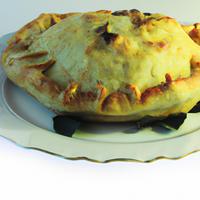
1 serving (100 grams) contains 450 calories, 6.0 grams of protein, 25.0 grams of fat, and 50.0 grams of carbohydrates.

Log this food in SnapCalorie

Nutrition Information
Calories |
900 | ||
|---|---|---|---|
% Daily Value* |
|||
| Total Fat | 50 g | 64% | |
| Saturated Fat | 20 g | 100% | |
| Polyunsaturated Fat | 0 g | ||
| Cholesterol | 40 mg | 13% | |
| Sodium | 800 mg | 34% | |
| Total Carbohydrates | 100 g | 36% | |
| Dietary Fiber | 4 g | 14% | |
| Sugars | 10 g | ||
| protein | 12 g | 24% | |
| Vitamin D | 0 mcg | 0% | |
| Calcium | 40 mg | 3% | |
| Iron | 4 mg | 22% | |
| Potassium | 160 mg | 3% | |
* Percent Daily Values are based on a 2,000 calorie diet. Your daily values may be higher or lower depending on your calorie needs.
Food Attributes
Source of Calories
About Pie pastry
Pie pastry is a versatile dough used as a base or covering in both sweet and savory pies. Created from a simple combination of flour, butter or shortening, water, and sometimes a pinch of salt or sugar, it has origins in European cuisine, particularly British and French baking traditions. The butter or shortening gives it a rich, flaky texture, while the flour provides structure. Although a good source of energy due to its carbohydrate and fat content, pie pastry is generally high in calories and saturated fats, depending on the type of fat used. It offers little in terms of protein, fiber, or essential vitamins. Opting for whole-grain flour or using less butter can make it slightly healthier. Its versatility makes it popular worldwide, appearing in everything from fruit-filled desserts to hearty meat pies. As with any indulgent food, moderation is key.



